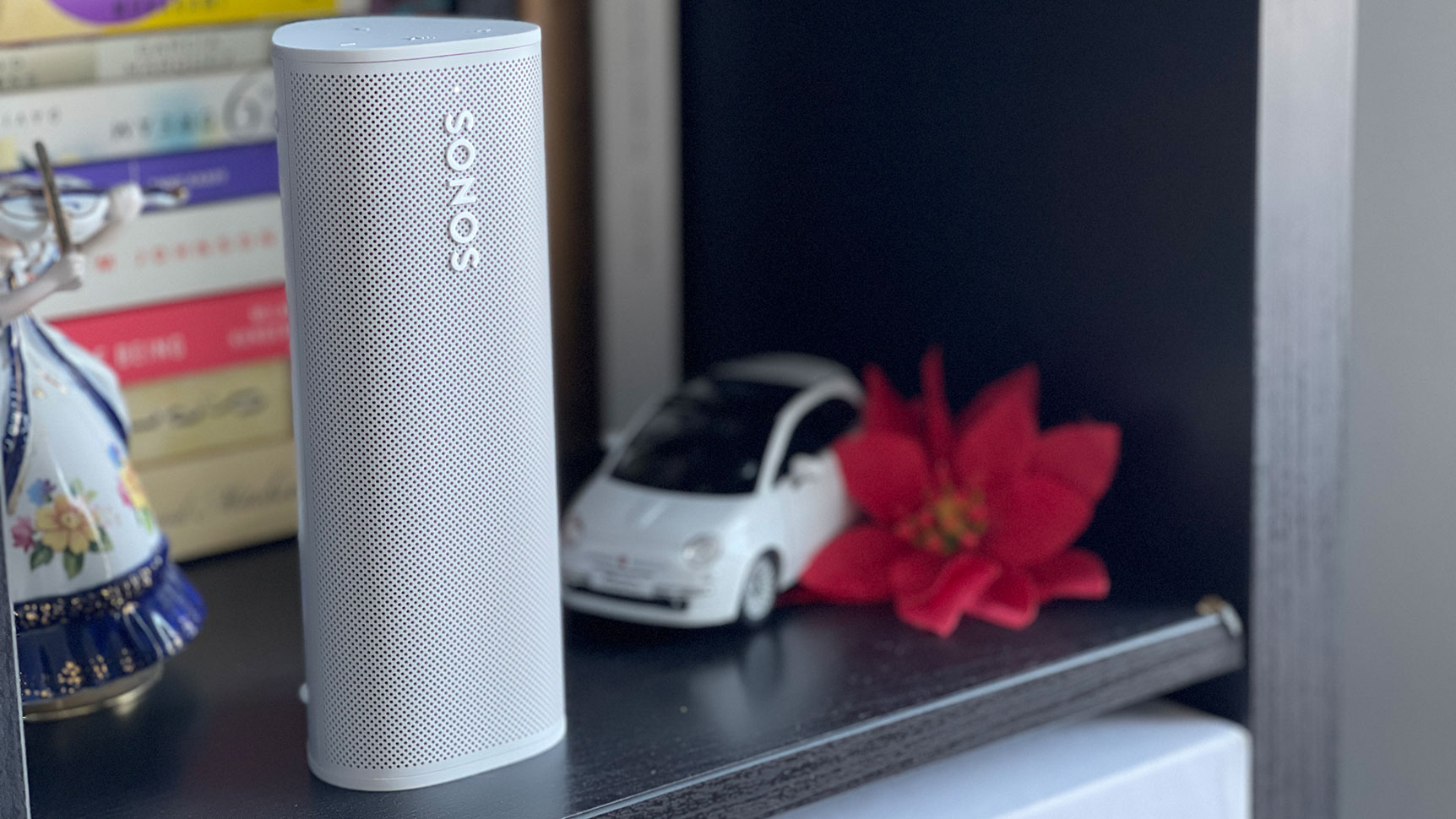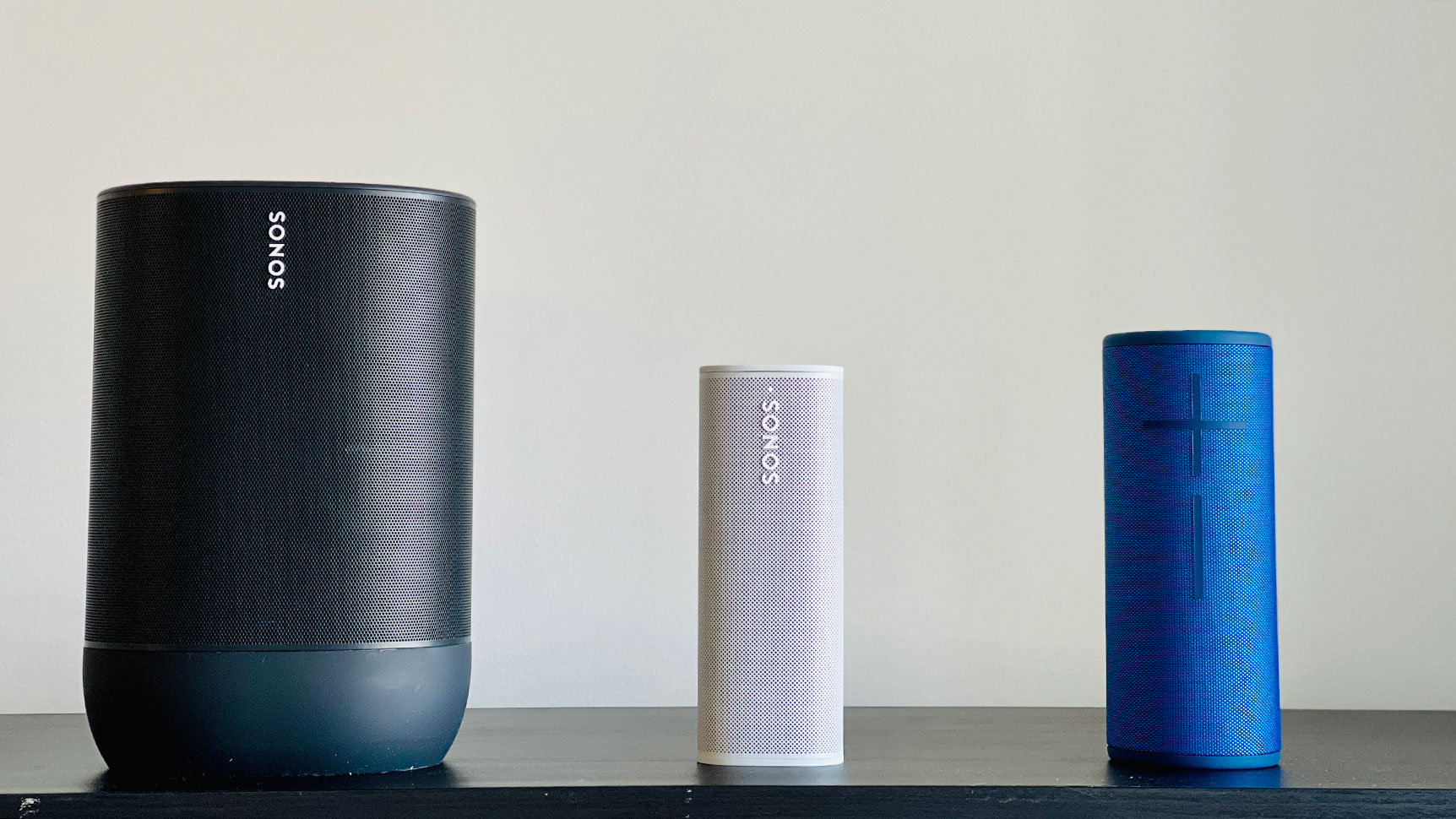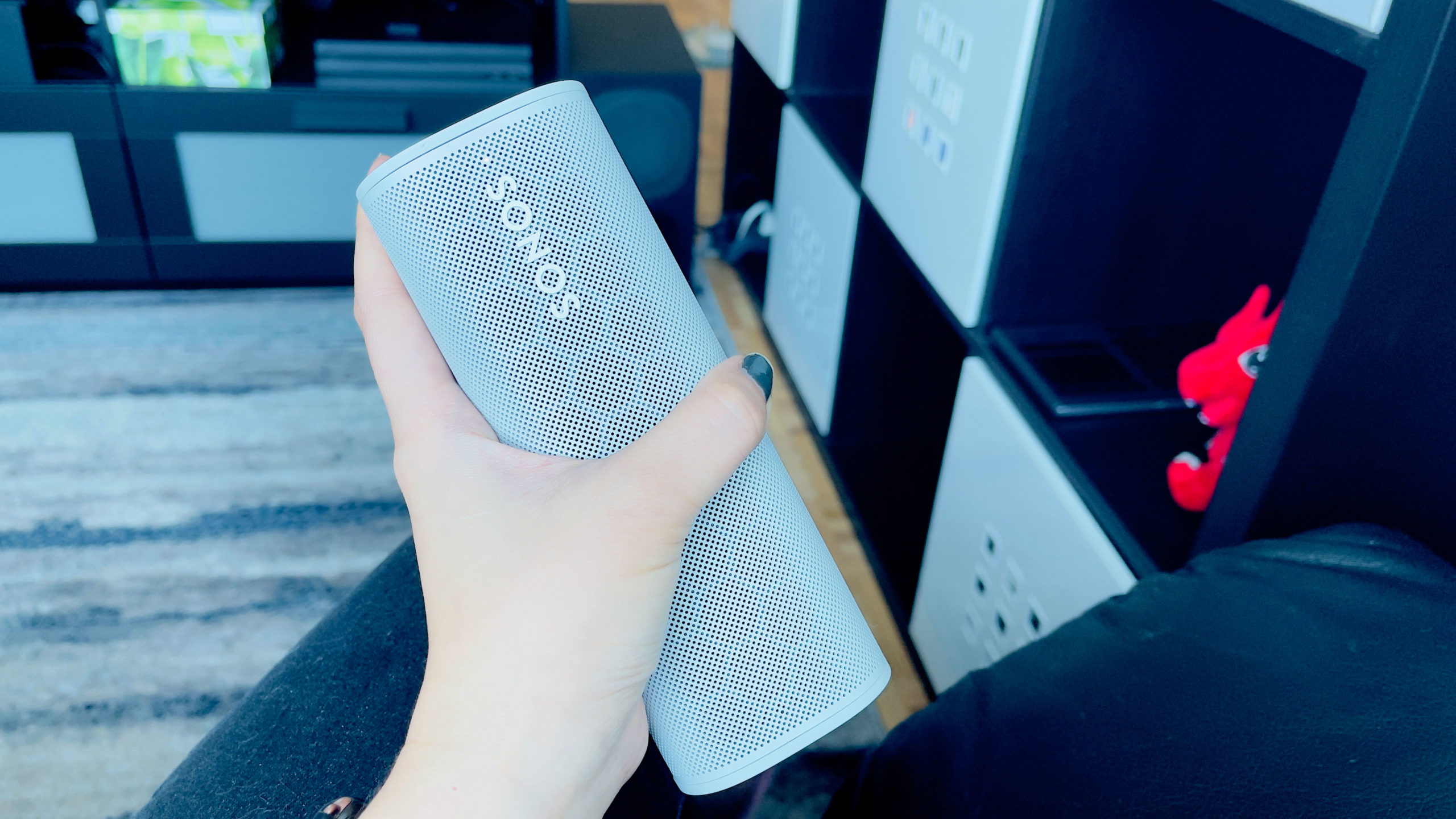One of the first times I ever came across a Sonos speaker was at a swanky outdoor barbecue on a Brooklyn rooftop. I remember it vividly, because the host stopped grilling to spew expletives at his two Sonos speakers. He’d created a specific playlist for the party but Sonos speakers at the time were Wi-Fi only — without Wi-Fi on the rooftop, his smart speakers looked pretty dumb.
That’s exactly the sort of scenario Sonos tried to address two years ago with its first Bluetooth speaker, the Move. The problem was that the speaker costs about $500 and wasn’t truly portable. Yes, it had a handle and you could schlep it around, but it measured a hulking 10 inches tall and weighed a hefty 3 kg. Sonos’ latest attempt is an actually portable Bluetooth and Wi-Fi speaker, the Roam.

Sonos Roam
What is it?
Sonos' first truly portable speaker
Price
$279
Like
Very light. Great sound quality. Affordable for a Sonos speaker. Can send sound from the Roam to another Sonos speaker.
No Like
Scuffs easily. Some of the advanced connectivity features aren't as seamless as I'd like.
At 6.6 inches long and 2.4 inches wide, the Roam is small enough to easily fit in your hand. Its triangular shape and matte finish also feel natural when you’re toting it around. It weighs in at slightly less than a pound, which feels substantial enough in your grip, but it’s not so heavy that you’re tempted to leave it at home. When you’re not moving around, you can stack it either vertically to save room or horizontally for more stability. (There are tiny rubber legs on one side so you know which way to orient it.)
As for design, what can I say? The Roam has that sleek Sonos vibe. On the back, you’ll find a USB-C charging port and the power button. Up top (or on the left side, if it’s horizontal) you’ll find the microphone button, volume controls, and the play/pause button. There are also three tiny LED lights to indicate whether the microphone is on, whether you’re connected to Bluetooth or wifi, and if it’s charging. In terms of durability, the Roam is rated IP67 for dust and water resistance. I stuck it in a bowl of water for 30 minutes, and while it sprayed water all over my kitchen counter, it still worked afterward. It’ll be fine if you get caught in a downpour or accidentally knock it into a pool. Just don’t dilly dally in retrieving it.
[referenced id=”1127989″ url=”https://gizmodo.com.au/2018/09/ultimate-ears-boom-megaboom-review/” thumb=”https://gizmodo.com.au/wp-content/uploads/2018/09/12/gcqfjewfifebxfrfjags-300×169.jpg” title=”The UE Boom 3 Is Good Redesign At Its Best” excerpt=”One of my first Gizmodo stories was about Logitech getting serious about design. It was published a few weeks after the company released the first UE Boom, which we would eventually decide was the best Bluetooth speaker you could buy. At the time, I wondered how that little beast would…”]
I did have three quibbles. First, my Lunar White review unit scuffed easily, especially if I tossed it into a backpack with my keys and other objects. This might not be an issue if you opt for the black version, and thankfully, the marks came off with a bit of water. And while the Roam is definitely portable, it doesn’t have any sort of loop to hang it on something like a carabiner. You have to either hold it or set it down. That’s fine if you want to hang out by the pool or at a picnic — it’s more of a concern if you’re looking for something to accompany you on a biking or hiking trail. Lastly, I found the power button to be finicky. Because it’s quite low-profile, I sometimes had a hard time determining if I was actually pressing the damn thing.
Those are small quibbles. The most important thing to know is that Sonos didn’t skimp on audio quality in its pint-sized speaker. You’ve got two class-H amplifiers, one tweeter, and a custom racetrack mid-woofer. Without tweaking the EQ settings, the Roam has a bass-forward profile that’s rather impressive considering its size. I compared it to the Move and the Ultimate Ears Boom 3, and as you might expect, it falls somewhere in the middle. The Move definitely sounds richer and gets louder, but the Roam holds its own, even in outdoor spaces. It’s loud enough to fill my two-bedroom apartment, as well as turn the heads of passersby in the park. The Boom 3 is extremely loud and has good sound quality, but overall, it sounds hollower than the Roam. This is most noticeable with bass-heavy songs. Dua Lipa’s “Physical” and Joji’s “Slow Dancing in the Dark” physically rumble on the Roam. On the Boom 3, they simply do not. (They still sound good, though.)

The Roam’s default EQ settings are bass-forward, but that doesn’t mean the mids and trebles sound bad. The trumpet section in Phoebe Bridgers’ “I Know the End” sounds crisp, and the Roam handles both Britney Spears’ breathy vocals and Bhangra elements in “Toxic” with aplomb. It also did a good job with the dynamic shifts in volume in both Gershwin’s “Rhapsody in Blue” and the chorus of Mitski’s “Your Best American Girl.”
The Roam also has Sonos’ trademark automatic Trueplay feature, which tunes the speaker in real time based on its surroundings. I listened to music in an echo-y bathroom, and also placed the Roam in a bookshelf, but didn’t notice much of a difference in the audio. (Which, I suppose, is a sign that Trueplay works.) This doesn’t exactly translate to the outdoors — after all, what is there to bounce sound waves off of in an open field? This is one area where the Boom 3 is better. Because it shoots sound in all directions, it doesn’t matter where you’re standing in the great outdoors. When you’re outside, you definitely have to aim the Roam’s grille toward you.
But while the Roam ticks off most of the boxes in terms of design and audio, the connectivity features weren’t as seamless as I’d have liked.
The whole point of the Roam is so that you can, well, roam. According to Sonos, this speaker “automatically connects to your home network and pairs with your phone when you’re away.” That sounds a lot like how your phone automatically switches between Wi-Fi and mobile. In practice, it’s not quite that smooth.

One thing we didn’t love about the Move was the finicky Wi-Fi-to-Bluetooth-to-Wi-Fi transition. Unfortunately, that applies to the Roam as well. When I left my apartment with a song playing via the Sonos S2 app, the speaker would fall silent once the song finished. I’d have to manually pair over Bluetooth to get my playlist going. To do that, you long-press the power button until you hear a chime and the indicator light turns blue. The effect worked better if I did that while I was leaving the apartment. That’s easy enough to do, but it’s not the automatic re-pairing I thought I’d get. Also, when I returned home, the speaker didn’t immediately switch back over to Wi-Fi. Another small reminder: While the Sonos Roam is compatible with Alexa and Google Assistant, you can’t use them over Bluetooth (aka outdoors).
To be fair, these connectivity issues aren’t dealbreakers. I don’t generally leave my apartment and walk down the hallways holding a speaker that’s actively playing music. That’s weird. Even for backyard barbecues or pool parties, I tend to bring my speaker outside and then turn it on for my jams. This might be more of an issue if you live in a single-family house and want to seamlessly transition from indoors to your backyard. But again, holding a button isn’t a huge deal.
More interesting is the new sound swap feature. You long-press the play/pause button, and if you have multiple Sonos speakers, you can transfer sound from the Roam to another Sonos speaker. For example, if you use the Roam in the bathroom and move to the kitchen, you can press the button and send the song there. You can also “take the song back” by holding the button again. If the two speakers are in proximity, you can also press the play/pause button on both to play it on multiple speakers simultaneously. This is legitimately cool! It’s not the most necessary thing in my NYC apartment, but it could be helpful if you live in a house.
But while the sound swap feature is neat, it’s not always intuitive. For instance, any song transfer has to be initiated from the Roam. It also didn’t work when I tried to use it over AirPlay 2. I had to use Sonos’ S2 app to play my music and then it would work. That’s OK, because you can link almost all the major music streaming services, but I found it irksome. I prefer using AirPlay 2 to browsing through the S2 app, because it doesn’t let me search through Apple Music for stuff that’s not already saved in my library or whatever’s on Apple Music’s radio. And I can easily hit the AirPlay 2 menu on my iPhone to switch up which speaker is playing.

Let’s talk battery. The Sonos Roam is rated for 10 hours of continuous playback and can last up to 10 days in sleep mode. I didn’t play music for 10 hours straight, but I’ve only had to charge it once in the week and a half I’ve been testing it. That said, even though the Roam comes with a USB-A to USB-C cable, you also need to check that you have a 10W or more powerful adaptor. You can’t plug it into one of those tiny bricks that came with your iPhone, or charge it via your laptop. Sonos makes a $65 wireless charger for the Roam (sold separately) but I’d recommend using literally any other Qi wireless charger you might already have.
The $279 Roam may be the cheapest Sonos speaker, but it’s still pricier than most Bluetooth rivals. Its closest competitor, the UE Boom 3, is $100 less at $149. Whether you should opt for one over the other depends on your individual sound preferences and how you plan to use these speakers.
Having used both, I honestly prefer the Roam. Most of that is because I just think it sounds better, but it also slots better into my smart home life. The UE Boom 3 would be better if you’re looking for a durable speaker with longer battery life and the option to go hands-free. But the real deciding factor is how you feel about Sonos as a whole. If you’re already a Sonos fan, you probably decided to buy this thing several paragraphs ago. If you hate Sonos, I’m surprised you made it this far. If you’re intrigued but unsure you want to commit to this pricey speaker ecosystem, I’d say the Roam is the best option to see if the whole Sonos thing is your vibe. Not only is it relatively affordable, but even if the smart features aren’t your jam, at least you still have a great portable Bluetooth speaker.
